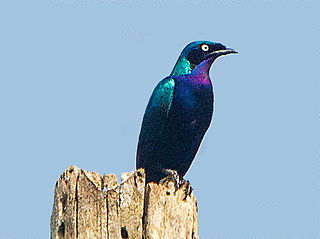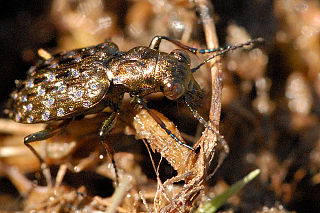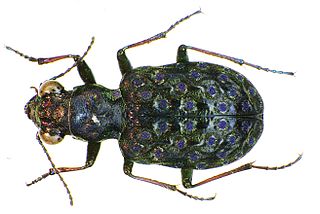
Synchiropus splendidus, the mandarinfish or mandarin dragonet, is a small, brightly colored member of the dragonet family, which is popular in the saltwater aquarium trade. The mandarinfish is native to the Pacific, ranging approximately from the Ryukyu Islands south to Australia. It can usually be found in some of the warmer waters.

The splendid toadfish also called the coral toadfish and the Cozumel splendid toadfish is a species of toadfish once believed to be entirely endemic to the island of Cozumel but have been found on the reefs of Honduras all the way up to Cancun. Commonly found under coral outcroppings. Dens can be spotted by the sloping sand patch. They are very difficult to coax out in the open.

Elaphrus viridis, the Delta green ground beetle, is a species of ground beetle restricted to a small region within Solano County, California. Its color is a metallic-green, usually with bronze spots on its elytra, though some lack these spots. The lack or reduction of circular pits on the elytra helps distinguish it from other ground beetles. Typical adults are about a quarter-inch (0.6 cm) in length.

The splendid lanternshark is a shark of the family Etmopteridae found in the western Pacific at depths between 120 and 210 m. Through the classification of Etmopterus species into several clades based on the positioning of their bioluminescent photophores, the splendid lanternshark can be considered a member of the Etmopterus pusillus clade.

Tarzan and the Lost Empire is a novel by American writer Edgar Rice Burroughs, the twelfth in his series of twenty-four books about the title character Tarzan. It was first published as a serial in Blue Book Magazine from October 1928 through February 1929; it first appeared in book form in a hardcover edition from Metropolitan Newspaper Services in September 1929. This was the first Edgar Rice Burroughs book not published by A. C. McClurg, with whom Burroughs had cut off business ties due to a dispute over royalties.
Coreoleuciscus splendidus, also known as the swiri or Korean splendid dace, is a species of fish from the cyprinid family endemic to rivers of the Korean peninsula. It was first scientifically described by Tamezo Mori in 1935, who noted in 1936 that it could be found spawning in Gyeongsangbuk-do's Uljin County; a 1939 study also found it in the Geum and Seomjin rivers. A South Korean survey conducted between April 1966 and November 1989 of 4909 sites south of the Korean Demilitarized Zone found it in 659 sites; it was not seen to appear in the Yeongsan, Sapgyo, or Anseong rivers. It typically spawns between the beginning of May and the middle of June.

The Seychelles swiftlet is a small bird of the swift family. It is found only in the Seychelles Islands in the Indian Ocean.

The splendid starling, also known as the splendid glossy-starling, is a species of starling in the family Sturnidae.
The Ranongga white-eye or splendid white-eye is a species of bird in the family Zosteropidae. It is endemic to the Solomon Islands.

Metallyticus splendidus is a rare species of praying mantis found in Southeast Asia. It has an iridescent appearance.

Elaphrus is a genus of ground beetle native to the Palearctic, the Nearctic, the Near East and Northern Africa. It contains the following species:

Elaphrus riparius is a species of ground beetle native to the Palearctic and the Near East. In Europe, it is found in Austria, Belarus, Belgium, Great Britain including Shetland, Orkney, Hebrides and Isle of Man, Bulgaria, Croatia, the Czech Republic, mainland Denmark, Estonia, Finland, mainland France, Germany, Hungary, Republic of Ireland, mainland Italy (doubtful), Kaliningrad, Latvia, Liechtenstein, Lithuania, Luxembourg, Northern Ireland, mainland Norway, Poland, Russia, Slovakia, Slovenia, mainland Spain, Sweden, Switzerland, the Netherlands, Ukraine and Yugoslavia.

Elaphrus cupreus is a species of ground beetle native to the Palearctic. In Europe, it is found in Austria, Belarus, Belgium, Bosnia and Herzegovina, Great Britain including Shetland, Orkney, Hebrides and Isle of Man, the Czech Republic, mainland Denmark, Estonia, Finland, mainland France, Germany, Hungary, the Republic of Ireland, mainland Italy, Kaliningrad, Latvia, Liechtenstein, Lithuania, Luxembourg, Northern Ireland, mainland Norway, Poland, Russia, Slovakia, Slovenia, Sweden, Switzerland, the Netherlands, and Ukraine.

Elaphrus uliginosus is a species of ground beetle native to the Palearctic realm. It is widespread but rare in Europe, and is absent from much of Southern Europe. It is a wetland and coastal species.
Elaphrus americanus is a species of ground beetle in the subfamily Elaphrinae. It was described by Pierre François Marie Auguste Dejean in 1831.
Elaphrus californicus is a species of ground beetle in the subfamily Elaphrinae. It was described by Mannerheim in 1843.

Elaphrus fuliginosus is a species of ground beetle in the subfamily Elaphrinae. It was described by Say in 1830.
Elaphrus lecontei is a species of ground beetle in the subfamily Elaphrinae. It was described by Crotch in 1876.
Elaphrus purpurans is a species of ground beetle in the subfamily Elaphrinae. It was described by Hausen in 1891.
Elaphrus tuberculatus is a species of ground beetle in the subfamily Elaphrinae. It was described by Maklin in 1878.











